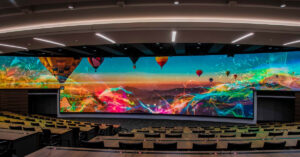
Video Building Block: Bit Depth
Published October 16, 2020

This week we discuss a building block vital to not only video but all digital media and communication!
What is bit depth?
Before we go any further, let’s take a step back and look at the digital medium. Computers use binary code, strings of 1s and 0s, to communicate. Each number is called a binary digit or bit. With tons of those 1s and 0s, we can created videos, audio, websites, computer programs, and lots of other creative options. Safe to say, many smart people figured these things out and we get to reap the benefits. It’s still good to have a general understanding for choosing and using your equipment.
Bit depth (also referred to as color depth) determines the depth of quality for each pixel. The greater the bit-depth, the greater the options for color. If you don’t want to go one step deeper into the technical, check out the chart below and skip to the next section!
For the technically minded, bit depth is the number of bits per channel each pixel can contain. Stick with me for a moment as we do some math.

8-bit is a smooth transition between light and dark
1-bit has two options: 1 or 0. The pixel can either be black or white.
2-bit has four options: 00, 01, 10, or 11. The pixel can be black, dark grey, light grey, or white.
3-bit has eight options: 000, 001, 010, 100, 011, 110, 111. Which means eight color options!

That’ s a clear sign of low bit depth
Your color options for each pixel exponentially increase with each bit added. To be precise, the equation is 2^N, N being the number of bits. So for an 8-bit video, each pixel has 256 options per channel. Those three channels are red, green, and blue. These RGBs are mixed to get your color choice. Which means our option grows exponentially again! An 8-bit pixel can be any of over 16.5 million colors!
Do we need higher bit-depth?
Again, it depends! According to a research study conducted for business branding, the human eye can perceive upward of 10 million different shades of color. That’s just over half of the color options represented by an 8-bit video but a 7-bit video wouldn’t have enough colors, at just above 2 million. So why go larger than 8-bit?
More bit depth has its benefits mainly for editors. If you’re editing your videos, higher bit depths means more information to pull out and adjust as needed. This allows for more creative choices, deeper color, and smoother gradients in the final product. Just like with higher resolution from last week, the more information you have to start with, the easier it is to remove info without ruining the image.
Bottom Line: Record video in higher bit depths to capture as much info as possible for editing. If you don’t plan to edit, the standard 8-bit option is perfectly acceptable and used everywhere today, from displays to everything on the internet.
Next week, we’ll learn about color gamut and color model, which are different from color depth!
Sources & Further Reading:
- https://www.unravel.com.au/understanding-color-spaces
- https://wolfcrow.com/what-is-color-color-bit-depth-and-a-color-model/
- https://en.wikipedia.org/wiki/Color_space
Want to get these articles a week in advance with extra deals and news? Sign up for our weekly newsletter, the Archer’s Quiver, and we’ll send you a FREE AV guide.
Get Expert AV Assistance
Latest Blogs
About Arrow AV Group
We are a premiere audiovisual integration firm serving corporate, government, healthcare, house of worship, and education markets with easy-to-use solutions that drive success. Family-owned and operated from Appleton, WI for over 35 years.




